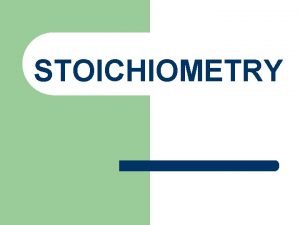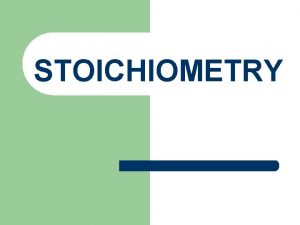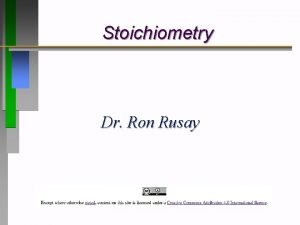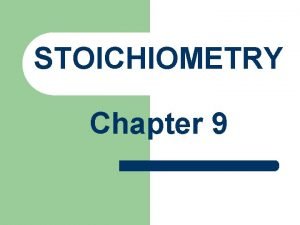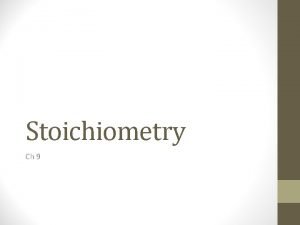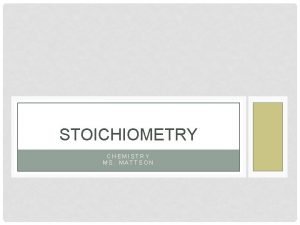Ch 9 Notes Stoichiometry Stoichiometry refers to the

















- Slides: 17

Ch. 9 Notes -- Stoichiometry • Stoichiometry refers to the calculations of balanced chemical quantities from_________ chemical equations. Measuring elements • Greek for “____________” • When baking cookies, a recipe is usually used, telling the exact amount of each ingredient double • If you need more, you can ________or triple _______the amount • Thus, a recipe is much like a balanced equation

Interpreting Everyday Equations 2 guards + 2 forwards + 1 center 1 basketball team ___ + ___ 2 G 2 F 2 C + ___ C _____ Practice Problems: 14 1) How many guards does it take to make 7 teams? ______ 2) How many forwards are there in 8 teams? ______ 16 3) If you have 8 centers, 17 forwards and 14 guards, how many teams can be made? ______ What do you run out of first? _____ 7 guards

Interpreting Chemical Equations 1 2 (g) + ___H 3 2 (g) ___NH 2 ___N 3 (g) • The first thing that must be done is to _______ the balance equation! • Here are the kinds of information you can get from the equation: ____ 1 mole N 2 + ____ 3 moles H 2 ____ 2 moles NH 3 ____ 1 molecule N 2 + ____ 3 molecules H 2 ____ 2 molecules NH 3 1 liter N 2 + ____ 3 liters H 2 ____ 2 liters NH 3 ____ 28. 0 grams N 2 + ____ 6. 0 grams H 2 ____ 34. 0 grams NH 3 ____

Mole-Mole Conversions coefficients The mole conversion factor comes from the _________ of the balanced chemical equation. Step 1: Write down the “given”. This becomes “x” Step 2: Set up a conversion factor to change from moles of “x” to moles of “y”. Practice Problems: N 2 (g) + 3 H 2 (g) 2 NH 3 (g) 1) How many moles of ammonia can be made from 7 moles of nitrogen reacting with an excess of hydrogen? 7 mol N 2 x 2 mol NH 3 = 14 moles of NH 3 1 mol N 2 2) How many moles of hydrogen are required to completely react with 8 moles of nitrogen to produce ammonia? 8 mol N 2 x 3 mol H 2 = 24 moles of H 2 1 mol N 2 3) How many moles of hydrogen are needed to react with an excess of nitrogen to 3 mol H 2 make 10 moles of ammonia? = 15 moles of H 2 10 mol NH 3 x 2 mol NH 3

Mole to Mole conversions continued 4) How many moles of O 2 are produced when 3. 34 moles of Al 2 O 3 decompose? 2 Al 2 O 3 → 4 Al + 3 O 2 3 mol O 2 = 3. 34 mol Al 2 O 3 x 5. 01 moles of O 2 2 mol Al 2 O 3 5) If 3. 84 moles of C 2 H 2 are burned, how many moles of O 2 are needed? 2 C 2 H 2 + 5 O 2 → 4 CO 2 + 2 H 2 O x 3. 84 mol C 2 H 2 5 mol O 2 2 mol C 2 H 2 = 9. 6 moles of O 2

Other Conversion Problems • Volume-Volume: (treat it exactly like a ______ mole-mole conversion) Step 1: Write down the “given”. Step 2: Convert from liters to liters using a mole conversion factor. N 2 (g) + 3 H 2 (g) 2 NH 3 (g) Practice Problem: How many liters of ammonia can be made from reacting 125 liters of hydrogen with an excess of nitrogen? 125 L H 2 x 2 L NH 3 3 L H 2 = 83. 3 L NH 3 …the long way to get the same answer… 125 L H 2 x 1 mol H 2 x 2 mol NH 3 x 22. 4 L NH 3 = 83. 3 L NH 3 22. 4 L H 2 3 mol H 2 1 mol NH 3

Molar Mass Review Practice Problems: (1) Calculate the molar mass of each compound. (Add up all the atomic masses for each atom from the Periodic Table. ) a) Ca. CO 3 1 Ca = 1 x 40. 0 = 40. 0 1 C = 1 x 12. 0 = 12. 0 3 O’s =3 x 16. 0 = 48. 0 b) (NH 4)2 SO 4 Add them up! 100 g c) C 3 H 6 O 3 C’s = 3 x 12. 0 = 36. 0 6 H’s = 6 x 1. 0 = 6. 0 1 O = 1 x 16. 0 = 16. 0 2 N’s = 2 x 14. 0 = 28. 0 8 H’s = 8 x 1. 0 = 8. 0 1 S = 1 x 32. 0 = 32. 0 4 O’s = 4 x 16. 0 = 64. 0 Add them up! 132. 0 g d) H 3 PO 4 Add them up! 58. 0 g 3 H’s = 3 x 1. 0 = 3. 0 1 P = 1 x 31. 0 = 31. 0 4 O’s = 4 x 16. 0 = 64. 0 Add them up! 98. 0 g

Stoichiometry Notes Part 2 • Mole-Mass: (moles to grams) Step 1: Write down the “given” (start moles of “x”). Step 2: Convert from moles of the “given” (x) to moles of the “unknown” (y) using a mole conversion factor. Step 3: Convert from moles of “y” to grams of “y” using molar mass. x N 2 (g) + y 3 H 2 (g) 2 NH 3 (g) Practice Problem: How many grams of ammonia, NH 3, can be made from reacting 20. 0 moles of hydrogen with an excess of nitrogen? 20. 0 moles H 2 x 2 mol NH 3 17. 0 g NH 3 x = 226. 67 g NH 3 3 mol H 2 1 mol NH 3

Other Conversion Problems • Mass-Mass: (grams to moles to grams) Step 1: Write down the “given” (x) and convert from grams to moles. Step 2: Convert from moles of the “given” (x) to moles of the “unknown” (y) using a mole conversion factor. Step 3: Convert from moles of “y” to grams of “y”. N 2 (g) + 3 H 2 (g) 2 NH 3 (g) Practice Problem: How many grams of ammonia can be made from reacting 39. 0 grams of nitrogen with an excess of hydrogen? 39. 0 g N 2 x 1 mol N 2 x 2 mol NH 3 x 17. 0 g NH 3 = 28. 0 g N 2 1 mol NH 3 47. 4 g NH 3

Other Conversion Problems • Mass-Mass: (grams to moles to grams) Step 1: Write down the “given” (x) and convert from grams to moles. Step 2: Convert from moles of the “given” (x) to moles of the “unknown” (y) using a mole conversion factor. Step 3: Convert from moles of “y” to grams of “y”. Cu + 2 Ag. NO 3 2 Ag + Cu(NO 3)2 Practice Problem: How many grams of silver are produced from the reaction of 17. 0 g of copper with an excess of silver nitrate, Ag. NO 3? 17. 0 g Cu x 1 mol Cu x 2 mol Ag x 108 g Ag 64 g Cu 1 mol Ag = 57. 38 g of Ag

Percent Yield • Percent Yield is a ratio that tells us how ________ a efficient chemical reaction is. • The higher the % yield, the more efficient the reaction is. % Yield = Actual or “experimental” Yield x 100 Theoretical or “ideal” Yield • actual The ______ yield is the amount you experimentally get when you run the reaction in a lab. • theoretical The ________ yield is the amount you are ideally supposed to get if everything goes perfectly. You can calculate this amount using stoichiometry!

Practice Problem: Percent Yield 2 H 2 (g) + O 2 (g) 2 H 2 O (g) 1) A student reacts 40 grams of hydrogen with an excess of oxygen and produces 300 grams of water. Find the % yield for this reaction. Step 1: Do a mass-mass conversion starting with the given reactant and converting to the product, (in this example, the water. ) The answer you get is how much water you “theoretically” should have produced. 40 g H 2 x 1 mol H 2 x 2 mol H 2 O x 18. 0 g H 2 O = 360 g H 2 O 2. 0 g H 2 2 mol H 2 1 mol H 2 O Step 2: The other value in the question, (300 grams), is what you actually produced in the lab. Divide them to get your % yield! % Yield = 300 x 100 = 83. 3% 360

Percent Yield Practice Problem 7 H 202 + N 2 H 4 2 HNO 3 + 8 H 2 O 2) The reaction of 11 g of N 2 H 4 with excess H 2 O 2 according to the following reaction yields 35 g of HNO 3. What is the percent yield? Step 1: Do a mass-mass conversion starting with the given reactant and converting to the product, (in this example, the HNO 3. ) The answer you get is how much water you “theoretically” should have produced. 11 g N 2 H 4 x 1 mol N 2 H 4 32 g N 2 H 4 x 2 mol HNO 3 1 mol N 2 H 4 63 g HNO 3 x = 1 mol HNO 3 43. 3 g HNO 3 Step 2: The other value in the question, (35 grams), is what you actually produced. Divide them to get your % yield! % Yield = 35 x 100 = 80. 8% 43. 3

• • Limiting Reagent (or Limiting Reactant) runs out first. The limiting reagent is the reactant that ______ The reactant that is in abundance is called the ______ excess reagent.

Calculations Step 1: Do a mole-mole conversion for one of the substances. This answer is how much of it you need. Step 2: Compare your answer to how much reactant was given. Do you have enough? If not, this reactant is your limiting reagent! Practice Problems: N 2 (g) + 3 H 2 (g) 2 NH 3 (g) 1) If 2. 7 moles of nitrogen reacts with 6. 3 moles of hydrogen, which will you run out of first? Were you given enough 2. 7 mol N 2 x 3 mol H 2 1 mol N 2 = 8. 1 moles of H 2 are H 2? ______ No ! (6. 3<8. 1) needed for the reaction. Limiting Reagent = ______ H 2 2) If 3. 9 moles of nitrogen reacts with 12. 1 moles of hydrogen, what is the limiting reagent? 3. 9 mol N 2 x 3 mol H 2 1 mol N 2 = 11. 7 moles of H 2 are Were you given enough H 2? ______ Yes ! (12. 1>11. 7) needed for the reaction. Limiting Reagent = ______ N 2

Excess Reagent (or Excess Reactant) How many moles of excess reagent do you have? Step 1: Do a mole-mole conversion starting with the limiting reagent as the given. • The answer you get is how much of the excess reagent you need to completely react with the limiting reagent. • Sometimes you get lucky and you already did this conversion from the previous problem! Step 2: Subtract this answer from the amount given in the original problem, and that is how many moles of excess reagent there are.

Excess Reagent (or Excess Reactant) Practice Problem: Find the number of moles of excess reagent from the previous practice problems. 6. 3 mol H 2 x 1 mol N 2 = 2. 1 moles of N 2 are needed for 3 mol H 2 the reaction. 2. 7 moles of N 2 were originally given, so the excess will be… 2. 7 moles given − 2. 1 moles needed = 0. 6 moles of N 2 excess • For the second practice problem, we already started with the limiting reagent, so all you have to do is subtract… 12. 1 moles given − 11. 7 moles needed= 0. 4 moles of H 2 excess
 In a chemical reaction, stoichiometry refers to
In a chemical reaction, stoichiometry refers to Cube wisc
Cube wisc Thiếu nhi thế giới liên hoan
Thiếu nhi thế giới liên hoan Phối cảnh
Phối cảnh Chúa yêu trần thế alleluia
Chúa yêu trần thế alleluia điện thế nghỉ
điện thế nghỉ Một số thể thơ truyền thống
Một số thể thơ truyền thống Hệ hô hấp
Hệ hô hấp Công thức tính độ biến thiên đông lượng
Công thức tính độ biến thiên đông lượng Số nguyên tố là
Số nguyên tố là Tỉ lệ cơ thể trẻ em
Tỉ lệ cơ thể trẻ em đặc điểm cơ thể của người tối cổ
đặc điểm cơ thể của người tối cổ Các châu lục và đại dương trên thế giới
Các châu lục và đại dương trên thế giới ưu thế lai là gì
ưu thế lai là gì Thẻ vin
Thẻ vin Các môn thể thao bắt đầu bằng tiếng chạy
Các môn thể thao bắt đầu bằng tiếng chạy Tư thế ngồi viết
Tư thế ngồi viết Cái miệng xinh xinh thế chỉ nói điều hay thôi
Cái miệng xinh xinh thế chỉ nói điều hay thôi






















